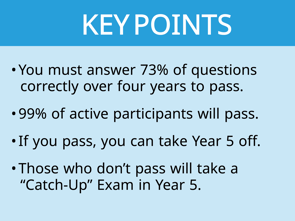By Stanley J. Miller, M.D.*
Most of you have already embraced CertLink, a longitudinal assessment that allows you to look up information (as you would in the clinic) and concentrate on knowledge most relevant to your practice – not obscure facts seen only in a textbook.

You may not have realized that CertLink has replaced the old Maintenance of Certification (MOC) Exam. The last MOC exam was given in 2022. Since then, data collected from CertLink participants has shown that the new platform is a viable assessment tool, and more effective for retaining knowledge than a high-risk, proctored exam.
CertLink Passing Standard is Set
Earlier this month, we announced that the cumulative passing score for CertLink is 73 percent correct after four years.
Based on everyone’s performance since CertLink’s rollout in 2020, we anticipate that the vast majority (more than 99%) of board-certified dermatologists will meet the passing standard if you actively participate in at least 3 quarters yearly.
We know you’ll have questions. Here are some answers:
Why is a Passing Score Necessary?
Setting a passing score and measuring cumulative performance is necessary to comply with new continuing certification standards adopted by the American Board of Medical Specialties (ABMS). (The ABD is one of 24 member boards of ABMS.)
Research shows that longitudinal assessments for continuing certification effectively support physician learning and have a positive impact on the care and treatment of their patients. Also, by participating in continuing certification, we demonstrate our lifelong dedication to professional growth and excellence.
For CertLink to be a valid assessment tool, though, a passing standard must be determined, with consequences if that standard is not met.
Almost everyone will meet the passing standard. After all, if you get a question wrong, you find out immediately and get a rationale supporting the correct answer. You will get the same question the next quarter, and if you have learned from your error, you will answer correctly. Your initial incorrect answer will not count toward your cumulative score. That is why we describe CertLink as “assessment for learning.”
The most likely reason to not meet the passing standard will be failure to participate.
What happens if I don’t meet the passing standard?
If you are not meeting the standard by the end of your fourth year, you will take a “Catch-Up Exam” in your fifth year. This exam will be a modified version of CertLink – you will have one week to answer all 150 questions. You will have 10 minutes to answer each question, but you will not get a second chance if your answer is wrong. Like CertLink, the Catch-Up Exam is open book.
If you do not pass the Catch-Up Exam, or if you decline to take it, your certification will lapse. You must pass the Catch-Up Exam before you can earn back your certification.
What happened to the 10-year cycle?
With continuing certification, there really aren’t cycles. Longitudinal assessment means you are continuously acquiring knowledge. Studies show that short assessments of relevant medical specialty information help physicians increase their understanding, knowledge, and skills.
Gone are the days when a diplomate would take a high-stakes exam in a testing center once every 10 years.
The new ABMS Continuing Certification Standards require evaluating a diplomate’s performance every five years. (“Member Boards must determine at intervals no longer than five years whether a diplomate is meeting continuing certification requirements to retain each certificate.”)
Our psychometricians (experts in the science of measurement) tell us that they need at least four years of data to ensure individual results are fair and accurate. (Learn more about how our exams are scored.)
And, as we have done for nearly 20 years, the ABD requires one practice improvement activity every five years. (Learn more about Focused Practice Improvement Modules.)
Will I be penalized if I opt to take the Catch-Up Exam instead of quarterly CertLink questions?
No. However, we do not recommend it because quarterly participation is more effective for learning and review, and for staying up to date.
With the Catch-Up Exam, you will not have a second chance to retake any questions you get wrong (unlike CertLink). This may reduce your chances of meeting the passing standard.
Also, the Catch-Up Exam will not offer article-based questions, so you won’t get exposure to the latest articles in the literature through CertLink.
Where can I get more information?
Check out our CertLink frequently asked questions (FAQs) on our website. We will update these FAQs as new information is made available, and as new questions come in from diplomates.
Meanwhile, please contact us at Communications@ABDerm.org with additional questions.
*About the Author

Dr. Miller is the ABD Associate Executive Director for Continuing Certification. He was in private practice in Towson, MD and affiliated with the University of Maryland St. Joseph Medical Center from 2002-2024. Previously, he spent 10 years as a full-time faculty member at Johns Hopkins Hospital. His experiences in both academic medicine and private practice have prepared him to lead the ABD’s continuing certification program. During the nine years he served on the ABD board of directors (plus two additional years as a CertLink consultant), he led the development of the CertLink platform.
Dr. Stan Miller explains how changes to ABD's Continuing Certification Program make CertLink an even stronger assessment for learning.

